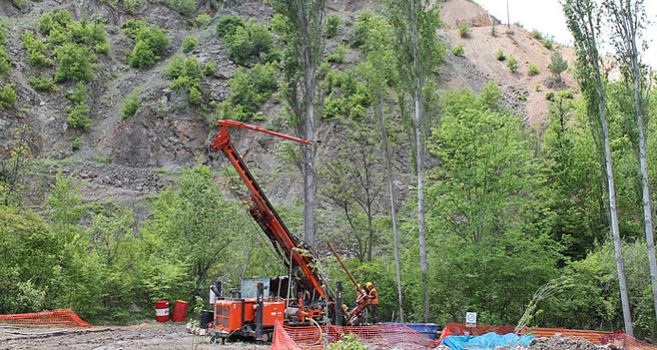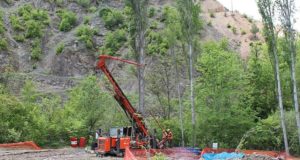Mariana Resources reports excellent gold assays from Turkey

Drilling at the Hot Maden gold-copper project in northeast Turkey. Source: Mariana Resources Ltd.

Mariana Resources Ltd. [MRA-TSXV; MARL-AIM] is providing the following update on the continuing diamond drill program at the high-grade Hot Maden gold-copper project in northeast Turkey.
Results are reported for a total of 13 infill and extension drill holes (HTD-63 to HTD-74 and HTD-76), with drill log data provided for a further seven holes (HTD-75 and HTD-77 to HTD-82) for which assays are pending. The infill drilling in the Main zone resource area has been focused on two new section lines (4,542,225N and 4,542,125N) and forms part of a program designed to uniformally reduce drill hole spacings to 25 metres by 25 m and to provide detailed geotechnical data for mine development studies. New resource drilling focused on both the Ridge area (southern limit of the Main zone resource) and the southern vein field discovery.
Highlights:
The highest grade gold-copper intercept to date from Hot Maden has been returned from initial drilling along two new infill cross-sections (4,542,125N and 4,542,225N). This infill drilling also successfully continues to confirm the internal continuity of gold-copper mineralization within the Main zone resource area.
Best results include: HTD-71: 69.6 metres at 62.7 g/t gold plus 2.68% copper from 210 metres downhole; including, from 210 -217 metres, 7 metres at 526 g/t gold plus 3.28% copper (ultrahigh-grade zone); including, from 217 – 231 metres, 14 metres at 27.7 g/t gold plus 3.38% copper (high-grade zone); including, from 231 – 279.6 metres, 48.6 metres at 1.7 g/t gold plus 2.39% copper (low-grade zone); HTD-70: 63 metres at 8.3 g/t gold plus 1.65% copper from 218 metres downhole; including 5 metres at 35.6 g/t gold plus 1.46% copper from 225 metres downhole; HTD-72: 34.5 metres at 19.4 g/t gold plus 1.31% copper from 180.5 metres downhole; including 3 metres at 54.4 g/t gold plus 1.30% copper from 192 metres downhole;
HTD-77: step-forward hole to HTD-72 which intersected 43.5 metres of massive sulphide mineralization from 96.0 metres and 41.5 metres of multiphase suphide-bearing breccia from 139.5 metres. Assays are pending.
The potential for the discovery of a deep (greater than 250 m), possibly fault-offset block of Main zone-type mineralization beneath the Ridge area (southern limit of the Main zone resource) has increased with the successful intersection of high-grade gold-copper mineralization at depth in two holes, HTD-69 and HTD-76.
Key results returned include: HTD-69: 7 metres at 19.7 g/t gold plus 2.1% copper from 351 metres downhole; HTD-76: 33 metres at 1.4 g/t gold plus 0.99% copper from 357 metres downhole; 11 metres at 6.1 g/t gold plus 0.97% copper from 443 metres downhole.
Further encouraging assays continue to be returned from discovery drilling in the southern vein field, including 4.6 g/t gold in HTD-66 (115 to 122.5 m). For more details refer to company press release.
Glen Parsons, CEO, said, “”Encouragingly, drilling at the current southern limit of the Main zone resource area has also intercepted what appears to be either a deep extension or an offset to the Main zone. The importance of this discovery is that we now see the potential to extend the Main zone mineral resource to the south.
“Further exploration drilling in the Southern discovery zone, located immediately to the north of the Old Russian mining zone, has also delivered strong mineralization from sulphide quartz veins and breccias which will ultimately add to the current initial inferred resource for this area. Exploration drilling successfully continues to work closer to, and into, the known mineralized Russian zone further to the south.
“Technical studies related to mine development are ongoing, and the work completed will be incorporated into both the preliminary economic assessment and prefeasibility studies accordingly. I look forward to updating the market on the anticipated PEA results which are now expected around the end of November, along with the further pending assays and ongoing drilling activities.”
